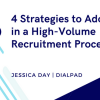Outsource got together with Raleen at last October's SIG Summit in Carlsbad, California, to hear about some of the key developments in the global labour market - and how procurement departments need to refine their approach to procuring people...
Outsource: Raleen, let’s begin with an introduction… Can you tell our readers what you do at ManpowerGroup?
Raleen Gagnon: I am the Director of Global Market Intelligence which sits within ManpowerGroup Solutions; and includes Business Intelligence, Market Intelligence, and Competitive Analysis. Within these three functions, we track candidate skills - such as Java or Agile project management across the globe - and measure supply and demand of key job skills in conjunction with labour costs, regulations, and productivity that may impact where or how employers should procure talent. Using competitive and business intelligence, we can then measure the impact of those workforce dynamics on a client’s workforce strategy through scenario models and other consulting services.
For many clients, we combine these functions, using business intelligence to do productivity and efficiency studies around the headcount; from an org structure standpoint we can then use competitive analysis to build profiles of certain organisations that they are competing against in the market to say how they have streamlined their procurement process, how they have streamlined their sales force and their go-to-market strategy, what their different value-added reselling channels look like from a headcount and investment standpoint. CI is all over the place - what's their product roadmap, what's this, what's that - but human capital is the largest op-ex that they will have, so being able to more properly assess and compare it to the competition is key. Our consulting practice has continued to grow as employers seek more insight to evaluate past and future workforce planning scenarios. In between that we publish insight and analysis in the Global Workforce Index, Quarterly Market Reports and the Workforce Insights Portal. We're trying to educate employers on who they are trying to hire, the laws they need to follow, and the most efficient wages and schedules to leverage in procuring that talent..
O: Which workforce trends are having the most impact on the procurement of labour going into 2017?
RG: Well it can certainly vary by industry or location around the globe, but there are a number of key trends that are fundamentally shifting procurement strategies globally. I would say that for organisations focused on cost savings, the most critical trends to consider in workforce planning are 1) taxes; 2) overtime regulations; 3) shift differentials; and 4) workforce quotas. With tax policies changing at the municipal level as well as the national landscape, fully loaded employment costs are shifting substantially in some traditionally lower-cost markets like China, so some employers may need to recalculate their budgets if they don’t want any surprises down the road.
Overtime and shift differentials are another big area right now - depending on the market and what their overtime premiums are, it may be less expensive to increase headcount than it would be to run overtime at 100% premiums plus night or weekend wage lifts. And workforce quotas… they aren’t everywhere yet, but it is increasingly common for ministries of labour to consider or implement requirements related to the percentage of an organisation's workforce that are contracted vs. employed or to restrict the percentage of foreign workers etc… Not planning ahead for those types of allocations can heavy financial repercussions to restructure after the fact if an organisation is caught unaware.
O: How closely do you personally work with clients?
RG: Quite a bit really. I go in on both the client and the prospect side, to educate them about which current trends are relevant to their strategy - for example here within the US how the overtime regulations for salaried workers are going to impact their contingent labour strategies in 2017; how certain roles fall under a category where they may become more expensive as permanent employees this year depending on the Department of Labor appeal. How paid sick leave or overtime and minimum wage laws are changing and impacting where a client should be hiring next year in the US. Provincial law in Canada.
A lot of my projects recently have been around sourcing strategy in Europe: "Well we've already invested in our bricks and mortar in these locations; but it turns out that the people we want to hire are no longer here…So where do we source them within the common travel area? How do we now tap into talent and find a new sourcing strategy that's going to help us justify the investment we have made here and not have us fall short of our performance numbers?"
There's a lot of heat-mapping skills and labour costs; sometimes it comes down to regulations: "These people make the same amount of money in this market as they would in your facility; however they are required to work five hours a week more on average than they would be required to work here, and these are their benefits locally - so you could pay them the same or less and actually improve their quality of life, and that is a value-added proposal - but you need to be hiring them differently." We do a lot of that, consulting engagement and delivery of insight and analysis related to how organisations could or should hire differently.
O: What are you doing here at the Summit?
RG: Well, firstly I have been asked to sit on the SIG Advisory Council. But beyond that, I am absolutely convinced that the industry needs more organisations focused on building out a new conversation around what labour strategies should be. While many industry groups are focused on the narrative related to Millennials, gender parity, and skills shortages, few actually propose solutions beyond the academic. This event has elevated discussions among senior executives to compare strategies and results. This has been excellent forum for procurement executives to evaluate and determine how best to hire differently for themselves in order to compete in the market.
I just read an article in Harvard Business Review on the plane here - the whole issue was around the future of work - one example was AT&T and how they are retraining their entire workforce of some 280,000. They know they can't hire all the skills in the market to rebuild the business they want in the future, so they are leveraging the talent they have and retraining them. I have had consulting engagements with clients where it's been all about how to capture IT skills when they only have one or two years' experience; well, you hire them, and train them, and give them experience.
Organisations need to think differently - and SIG is a fantastic place for them to do that, and to have very different conversations with peer executives. Here we have been talking about how to leverage technology differently; how to partner effectively to reduce the number of layers between candidates and hiring managers (enabling candidates to find work faster and employers to fill their vacancies faster). It’s refreshing to see the different perspectives that are represented among procurement leaders thinking about how they procure talent: they are here because it is a priority, and how they prioritise hiring and what they think is important in the decision-making process is evolving as contingent labour becomes more complex.
O: Do you think there is a particular challenge when traditional procurement people procure people? As in, can hiring be bought in the same way as other services and are the skills required the same?
RG: That needs a five- or six-part answer! I think that any organisation which takes its traditional hardware or software procurement process and tries to mimic it to procure talent is going to run into a lot of problems. Software can't change its mind; software can't move or have a child: there are human factors which going to procuring talent which mean you need to have different resources working on procuring talent than you would have procuring technology. The process needs to be different - and we’ve done a few consulting projects on this of late.
There is a certain procurement life-cycle that goes into procuring IT services and skills from an outsourcing standpoint: you issue an RFI; you narrow down your list of potential providers; you issue an RFP - you put together a task force to build out what RFP looks like and then you have to review it; then there's Q&A; then there's a narrowing-down to a final list; then you have presentations - and suddenly two months have passed. That's fine if you are procuring products or services from businesses - they're going to continue down their path and work on their other business - but when you are procuring talent three weeks later they have accepted another offer... So you can't have such a bloated process, you can't have the RFI consultation that makes everyone feel like they've done something that day because you asked 50 questions that, really, you don't need answered...
One of the more compelling aspects of the SIG event has been how vendors and procurement leaders have collaborated throughout the sessions. There’s been substantial discussion of how partnerships and process evolution can shift hiring efficiency and workforce performance. We’ve recently invested into third-party relationships in order to expand our access to market data and enhance our ability to advise clients on Total Talent Management, and topics like that appear to be a recurring theme among business leaders in attendance: why have we chosen to go down path A and path B, and not path C and path D? Because there is value in certain types of information that is more closely related to what will put candidates in seats.







